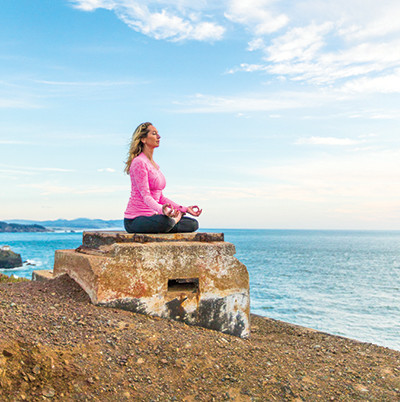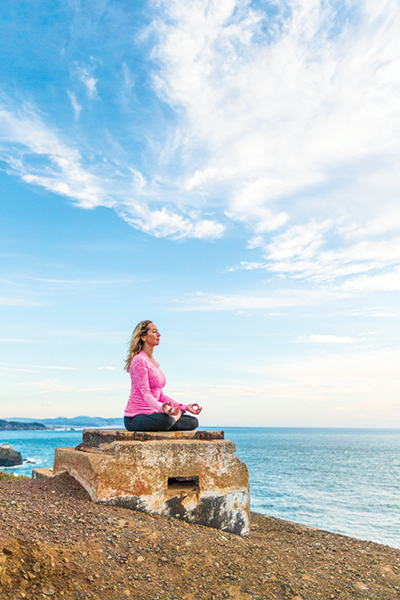IN A COUNTY KNOWN FOR FITNESS, it’s not surprising that the ancient practice of yoga has found its way into our daily lives. With more than 30 local studios and approximately 90 classes happening on any given day, one could easily say that at this moment somewhere, someone in the county is doing a downward dog. Now that the New Year is here and the associated resolutions are due, we asked some local yogis from a handful of studios to share their knowledge of the multiple benefits yoga brings — from strength and cardio to mindfulness and balance, the practice can help make 2017 your best year ever.
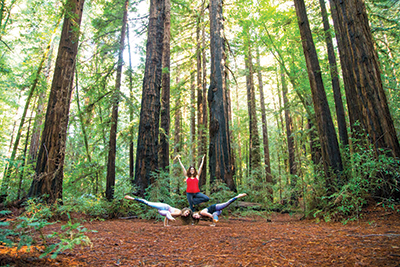
But first, a little background. Yoga originated in northern India with the Indus-Sarasvati civilization more than 5,000 years ago and has gone through many development phases. Merriam-Webster defines it as “a system of exercises for attaining bodily or mental control and well-being.” You’ll notice this definition has no mention of Lululemon or a music playlist; it’s about what yoga does for you on the inside. The modern phase of yoga’s development, which is primarily how we now think of yoga in the West, is referred to as hatha yoga, which was developed as a vehicle for meditation. Mix that with hardwood-floor studios, sound systems and sweat-wicking Lycra, and you have a scenario where Swami Sivananda (one of the original founders of the practice) would most likely be impressed but scratching his head. Still, the poses now being taught usually adhere to the fundamental principles. Today’s studios offer many variations of yoga practice, including vinyasa flow, ashtanga yoga, Iyengar yoga, yin yoga — in plain English, that’s truly something for everyone.
For the story in the following pages, we ventured up coastal bluffs and into redwood groves to find Marin instructors practicing in their habitat, hoping to remind readers that yoga poses can be done anywhere, anytime. Enjoy the scenery and experts’ pointers. Here they will pinpoint the benefits and fundamentals of yoga.
POSE: Vasisthasana (Side Plank)
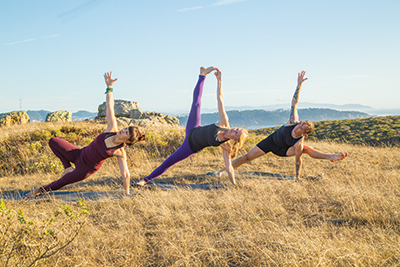
TRANSLATION: Most richest pose; vasistha means “most richest/wealthy,” asana means “pose.”
WHO: Charlene Lowe, Erika Trice and John Berlinsky of YogaWorks
WHERE: Hawk Hill, Marin Headlands
WHY: Side planks (and planks) have gotten lots of accolades lately from those interested in building their core muscle group. The simple act of opening your chest and expanding the rib cage increases lung capacity and floods your body with vital oxygen. Not only does it strengthen the back and chest, but since this is a balancing pose it automatically gets to your core, increasing stomach strength and thereby potentially reducing back strain. One study published in the Journal of Strength and Conditioning found this weight-bearing (hence bone-building) activity causes 100 percent activation of your six-pack muscles, whereas crunches engage only 64 percent. While doing a side plank on its own doesn’t burn as much fat as cardiovascular exercise, because it is a strength training activity it is a more efficient way of burning fat. Why? Because when you engage in strength training, your metabolic rate increases even after you’ve stopped exercising. And don’t forget the mindful benefits — weight-bearing exercises are also reputed to relieve stress, boost your mood and improve concentration.
HOW: “A safe and easy way to enter into vasisthasana is by aligning the body in side plank pose, and then shifting the weight to the chosen hand and foot. Place the left hand directly underneath the left shoulder and place the outer edge of your left foot so it is rooted down into the earth and the energy rebounds through the body upwards. Widen the shoulder blades away from each other and release the shoulders away from the neck; the pelvis should be in a neutral position and both sides of the torso should be equal in length. Once aligned, you can lift the top leg or place the foot on the thigh and externally rotate the top hip to form a tree pose variation,” says Charlene Lowe.
POSE: Pincha Mayurasana Padmasana (Forearm Stand in Lotus Position)
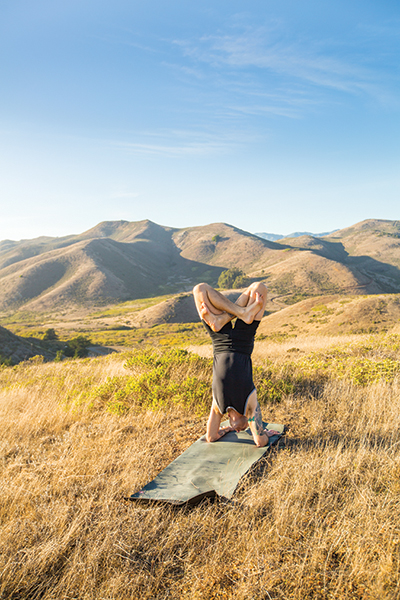
TRANSLATION: Peacock feather; pincha means “feather,” mayura means “peacock,” asana means “pose.” Padmasana means “lotus throne” (padma means “lotus,” sana means “seat or throne).”
WHO: John Berlinsky of YogaWorks
WHERE: Hawk Hill, Marin Headlands
WHY: Resembling the peacock’s showy display of feathers, this pose (especially with the upside-down lotus topoff) takes skill, strength and patience to perfect. Being upside-down has health benefits for many parts of the body.
- Heart: as the blood flow reverses direction our heart gets a break, reducing blood pressure and heart rate. Once we are right-side-up, fresh oxygenated blood floods our body’s systems.
- Mood: flushing the adrenal glands stimulates the release of neurotransmitters and endorphins that allow you to immediately feel uplifted and can counteract depression, mood swings and seasonal affective disorder.
- Brain: increasing blood flow nourishes brain cells with more oxygen, resulting in improved concentration, memory and awareness.
- Digestion: when you invert your body it encourages pressure on the walls of the digestive tract, stimulating it and supporting its function.
- Immune system: inversions help to stimulate lymphatic cleansing and drainage, which clears toxins from the tissues and plays a vital role in improving the efficiency and effectiveness of the immune system.
- Skin: reversing gravity flushes fresh nutrients and oxygen to the face, activating facial capillaries and scalp hair follicles and helping to remove visual signs of toxicity (including acne), giving your skin a healthy glow. This pose also helps strengthen the shoulders, upper arms and upper back. And for a bonus, as your abdominal muscles, legs and buttocks work to keep the body straight, they get toned too.
HOW: “In this pose, the body is completely inverted and held upright, supported by the forearms, shoulders and abdominals. Achieving the pose requires a combination of excellent upper body strength integrated with the core, controlled breathing (pranayama) and solid concentration, all coming together in a delicate balance. To work up to this pose, try poses that help to build up the core strength required to get into forearm stands and headstands, such as planking and crow pose,” John Berlinksy says.
POSE: Eka Pada Raja Kapotasana (Standing Mermaid) and Padmasana (Seated Lotus Throne)
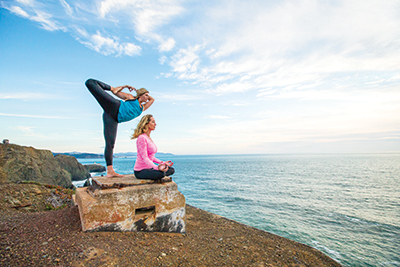
TRANSLATION: Padma means “lotus,” sana means “seat or throne.”
WHO: Kaelan Wolford (standing) and Susan Hauser (seated) of New Om World
WHY: (lotus) With the possible exception of the warrior, no other pose signifies yoga as much as the lotus. Featured on logos, seen being practiced in parks and liked on Instagram, the lotus pose (padmasana) is the signature yoga position — a universal symbol of peace and tranquility. The arrangement of hands and feet in the pose resembles the petals of a lotus flower and its benefits are widespread. While you’re in lotus, the tailbone and sacral nerves are toned as the normally large blood flow to the legs is redirected to the abdominal region, which may help to improve digestion. The lotus pose helps stretch the hips and the deep buttock muscle called the piriformis. Piriformis syndrome, which is characterized by tightness in good pose for women, lotus helps ease menstrual discomfort, and consistent practice of this pose until late into pregnancy is said to help ease childbirth. With the spine straight, this pose stimulates circulation in the pelvis, abdomen and bladder and helps support good posture. this small muscle, can be a cause of sciatic pain. An especially
HOW (lotus): “I don’t recommend it to people with knee problems. To get into this pose you need to be flexible and prepared to put in time to open your connective tissues. To start, you want to keep an upright spine and externally roll your shoulders open. Then stack each foot to opposing inner thighs. Unlike most of the poses in my classes, this is a yin pose, which means it is meditative as you sit and quiet your mind. Focus on your breath, as you open your hips, ankles and knees,” Susan Hauser says.
HOW (standing mermaid): “While standing mermaid offers no additional health benefits over other similar poses, it is a playful power pose especially good for opening the heart. I usually start in the half moon position (balance on my right leg, hips aligned with my right hand touching or reaching for the ground) and from there I work my balance until I am comfortable, finally bringing my foot to the crease of my elbow. Find a spot to focus on (often called your drishti in class) and be sure you are grounded in your foundation and balanced on your standing leg. Once you feel strong, peel open your hip, and at the same time lean forward and lift your chest up. Be careful to not hyperextend your knee, and enjoy,” Kaelan Wolford says.
POSE: Eka Pada Rajakapotasana II (One-Legged Pigeon or Mermaid)

TRANSLATION: Eka means “one,” pada means “foot or leg,” raja means “king,” kapota means “pigeon,” asana means “pose.”
WHO: Susan Hauser and Kaelen Wolford of New Om World
WHERE: Marin Headlands
WHY: Besides being a visual favorite (who doesn’t look great as a mermaid?) this advanced pose opens your hips as it lengthens and strengthens your back. The benefits of hip openers are improved range of motion and circulation and decreased back pain; the position is said to promote an energetic shift or release as well. As you will hear in your yoga classes, the hips are a storage ground for negative feelings and pent-up emotions, especially ones related to control in our lives. Hip opening can create the space for new ideas and new pathways. The shoulders and chest are also opened here, increasing circulation and detoxification and stimulating abdominal organs, aiding in digestion.
HOW: “It takes time and practice to open your connective tissues and be able to execute advances poses like mermaid. This is an advanced variation of the pigeon pose that combines a deep hip-opening stretch with an energetic heart-opening backbend. From pigeon, keep your hips aligned forward as you place your foot into the crease of your elbow, then bind your hands. Don’t forget to breathe,” Susan Hauser says.
POSE: Eka Pada Adho Mukha Svanasana (One-Legged Downward Dog)
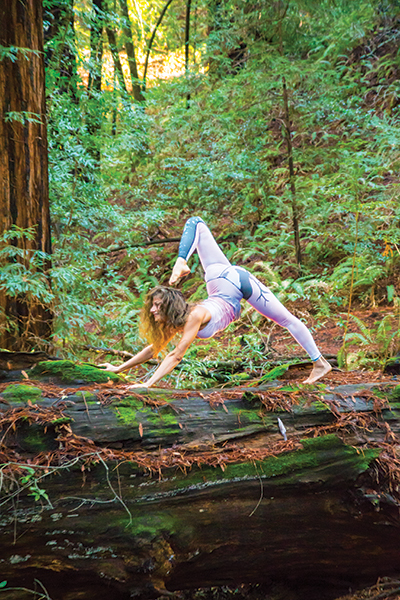
TRANSLATION: Eka means “one,” pada means “leg/foot,” adho means “downward,” mukha means “face,” svana means “dog,” asana means “pose.”
WHO: Anna Kyshynska of Red Dragon Yoga
WHERE: Roy’s Redwoods, Mill Valley
WHY: An advanced variation of downward dog, the three-legged dog (or downward dog split) is an excellent hip opener. This pose is the foundation of most yoga classes, as it offers a bevy of mental and physical health benefits. As a weight-bearing activity, it builds bone density and upper body strength, which not only makes you look good but helps to stave off or manage osteoporosis. The feet benefit from the continual pointing and flexing, which also keeps you nimble and prevents injury when you’re running, walking or hiking. Internal benefits include digestive relief, and many allergy sufferers also report feeling better from the inversion. As with all inverted poses where your heart is above your head, the increased blood flow to the brain energizes and calms the body and promotes a healthier complexion (sometimes called a yoga glow).
HOW: “Keep your standing leg strong and your shoulders squared to the top of your mat. Imagine that your hands and heels are aligned along one straight, diagonal line. To open your hips even further, bend your right knee and lift it high toward the ceiling. Tilt your pelvis, drawing your right hip up. Lift your thigh high so that your right hip stacks directly above your left hip. Reach your right foot across the back of your body, as if you’re trying to touch your left ear with your right toes. Spread your fingers wide and press firmly through your palms and knuckles. Distribute your weight evenly across your hands,” Anna Kyshynska says.
POSE: Astavakrasana (Eight-Angle Pose)
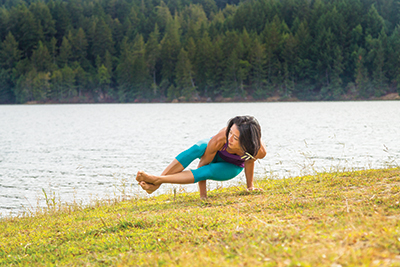
TRANSLATION: Asta means “eight,” vakra means “bent or curved,” asana means “pose.”
WHO: Grace Ling Yu of Marin Power Yoga
WHERE: Lake Lagunitas
WHY: If you look closely at a yogi doing the eight-angle pose, you might be able to imagine the mythological sage Astavakrasana, for whom the pose was named. According to legend he was born with eight crooked angles in his body as punishment for his father’s temper — one in the chest, one in the head/neck, and one in each hand, each foot, and each knee. This pose is advanced, and it can take years to perfect the balancing act required. The position strengthens the arms, wrists and shoulders, tones the belly and spine, and in its twisting helps promote detoxification of the body. Turning your torso also massages the abdominal organs, which improves digestion and detoxification.
HOW: “Warming up with sun salutations, chaturangas, core work, forward folds and hip openers is recommended before trying this pose. Start out in a seated pose with your left leg extended straight forward and right knee bent. Interlace your fingers underneath your right foot and lift your heel the same height as your right knee. Actively engage your arms by bending your elbows to deepen the stretch in your right hip. Sit up as tall as possible and stay for five breaths. If you would like to continue on to elephant’s trunk pose, keep holding on to your right foot with your left hand and round your spine and slide your right shoulder underneath the inside of your right knee. Take a few tries to keep getting your right leg higher over your shoulder, and then place your right hand down on your mat next to your right hip. To let go of your left hand, you must engage your right inner thigh muscle and hug in toward the center line of your body so that your leg does not slip down. When you are ready, place your left hand close to your left hip. Activate both feet, take a full breath, and on your exhale, straighten both arms, lifting your sit bones and legs off the floor into elephant’s trunk pose. Stay there for five breaths, then sit back down, keeping your right knee over your right shoulder. For the final step to get into astavakrasana, cross your left heel over your right ankle. Lift your sit bones and legs off the floor and continue to hug both legs in toward each other. Slowly bend your elbows to 90 degrees as if you are doing a chaturanga, and begin pointing your feet to the right. Combining core activation, arm strength, and inner thigh engagement will help you find the full expression of astavakrasana where your chest comes parallel to the floor in line with your elbows and feet. Stay for five breaths, then release and switch sides,” Grace Ling Yu says.

